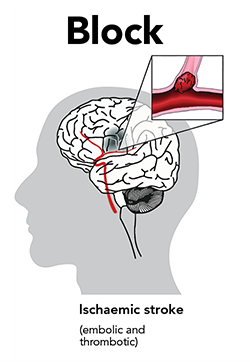Ischaemic stroke
A stroke can be caused by the blood supply being blocked. This is called an ischaemic stroke (is-key-mick). It is the most common type of stroke.
Usually it is a blood clot that blocks the blood supply. Clots help to stop bleeding from wounds, but they can also form within blood vessels, which are the tubes or pipes that carry blood around the body.
Blood carries oxygen and nutrients for your brain cells. Your brain can be injured if blood can’t get through.

Blood vessels include arteries, which carry blood pumped from the heart to the rest of the body, and veins, which return blood to the heart. If a clot blocks an artery to the brain it causes an ischaemic stroke.
Clots that cause strokes usually form either in the heart or in one of the large vessels that supplies blood to the brain. The clot then travels up and blocks a blood vessel in the brain. This is called thromboembolism.
Large artery disease
A common cause of ischaemic strokes is atherosclerosis, which is when cholesterol builds up as plaques on the inner walls of arteries. When these plaques get too big a clot can form.
These clots often form in the carotid arteries in the neck, which are the brain’s main supply of blood. They can also form in arteries within the brain.
Strokes in which a large artery is blocked can do a lot of damage because more of the brain is affected. However, these strokes can often be prevented by tackling risk factors like high blood pressure and high cholesterol. Find out how to prevent stroke.
Heart conditions
Clots often also form in the heart, due to:
- atrial fibrillation (AF), which is an irregular heartbeat. One of the smaller heart chambers doesn’t pump in a coordinated way. Blood then stagnates and clots can form.
- patent foramen ovale (PFO), which can connect the two sides of the heart. Clots that form in veins (e.g. deep vein thrombosis or DVT) can then cross to the arteries that supply blood to the brain. Babies need this connection before they’re born. It usually closes after birth, but can stay open in some people.
- damage to the heart, such as from infections or heart attacks, that affects pumping and can let clots form where blood flow stagnates.
Small blood vessels
A stroke that blocks narrow arteries deep within the brain is called small vessel disease. The risk factors are shared with clots in large arteries.
Small vessel disease can also be caused by rare genetic disorders like CADASIL, which affects muscle cells in blood vessels.
Other causes
A dissection or tear in a neck artery can form a clot at the break in the artery wall. Although dissections are uncommon, they happen more in younger people. The tear can be caused by damage to the neck, or by genetic risk factors such as fibromuscular dysplasia and vascular Ehlers–Danlos syndrome.
Sudden low blood pressure can cause a stroke in rare cases by reducing blood supply. This is called a watershed stroke because it mostly happens in the areas between arteries.
A rare autoimmune condition that causes inflammation of blood vessel walls, called cerebral vasculitis, can make arteries too narrow and create a clot.
Some blood disorders can make clots more likely. These are also rare, but they can lead to clots in veins within the brain, such as cerebral venous sinus thrombosis.
Another rare condition is a sudden constriction of blood vessels called reversible cerebral vasoconstriction syndrome. It usually causes sudden, severe, ‘thunderclap’ headaches, and can lead to ischaemic or haemorrhagic stroke.
